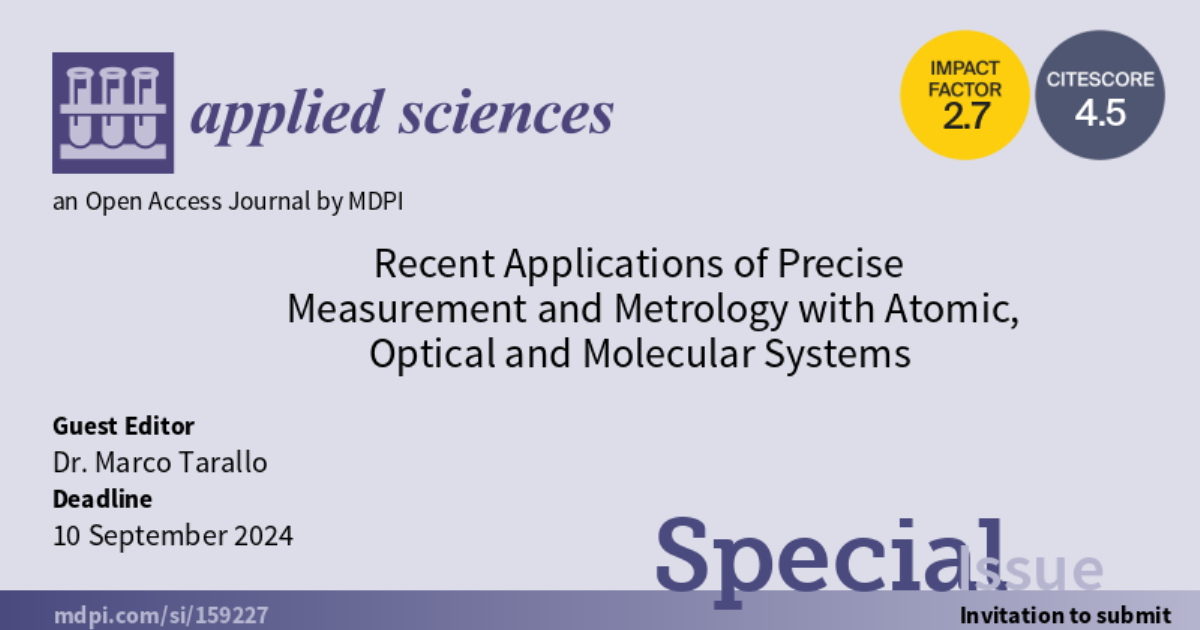Recent Applications of Precise Measurement and Metrology with Atomic, Optical and Molecular Systems
A special issue of Applied Sciences (ISSN 2076-3417). This special issue belongs to the section "Optics and Lasers".
Deadline for manuscript submissions: closed (10 September 2024) | Viewed by 3734

Special Issue Editor
Special Issue Information
Dear Colleagues,
Precise measurements with atomic, molecular and optical (AMO) systems are of paramount importance for both testing the basic laws of nature, and for the advancement of metrology towards its fundamental quantum limits. Precise AMO measurements span from optical, microwave and RF spectroscopy, to laser and matter-wave interferometry, magnetometry, etc., and require more and more sophisticated techniques to improve their detection capabilities. As a result, the improvement of precise measurements will reach the point of potential implementation outside of academic and research facilities, with applications in commercial, industrial and even military fields.
This Special Issue of Applied Sciences will highlight the most recent advances in AMO measurements and their fundamental, metrological and practical applications. The Special Issue will collect theoretical and experimental works dedicated to the study of problems emerging in the different contexts of AMO physics and metrology, including atomic and molecular clocks, matter-wave interferometry, optical magnetometry, gravimetry and inertial sensing, optical metrology, cavity ringdown molecular spectroscopy, and advanced techniques exploiting quantum measurements.
This Special Issue invites researchers to submit original research and review articles related to the application and realization of precise AMO measures.
Dr. Marco Tarallo
Guest Editor
Manuscript Submission Information
Manuscripts should be submitted online at www.mdpi.com by registering and logging in to this website. Once you are registered, click here to go to the submission form. Manuscripts can be submitted until the deadline. All submissions that pass pre-check are peer-reviewed. Accepted papers will be published continuously in the journal (as soon as accepted) and will be listed together on the special issue website. Research articles, review articles as well as short communications are invited. For planned papers, a title and short abstract (about 100 words) can be sent to the Editorial Office for announcement on this website.
Submitted manuscripts should not have been published previously, nor be under consideration for publication elsewhere (except conference proceedings papers). All manuscripts are thoroughly refereed through a single-blind peer-review process. A guide for authors and other relevant information for submission of manuscripts is available on the Instructions for Authors page. Applied Sciences is an international peer-reviewed open access semimonthly journal published by MDPI.
Please visit the Instructions for Authors page before submitting a manuscript. The Article Processing Charge (APC) for publication in this open access journal is 2400 CHF (Swiss Francs). Submitted papers should be well formatted and use good English. Authors may use MDPI's English editing service prior to publication or during author revisions.
Keywords
- atomic spectroscopy
- molecular spectroscopy
- microwave and RF spectroscopy
- optical metrology
- interferometry
- atomic clocks
- atom interferomentry
- laser interferometry
- precision measurements
- optical magnetometry
Benefits of Publishing in a Special Issue
- Ease of navigation: Grouping papers by topic helps scholars navigate broad scope journals more efficiently.
- Greater discoverability: Special Issues support the reach and impact of scientific research. Articles in Special Issues are more discoverable and cited more frequently.
- Expansion of research network: Special Issues facilitate connections among authors, fostering scientific collaborations.
- External promotion: Articles in Special Issues are often promoted through the journal's social media, increasing their visibility.
- Reprint: MDPI Books provides the opportunity to republish successful Special Issues in book format, both online and in print.
Further information on MDPI's Special Issue policies can be found here.





